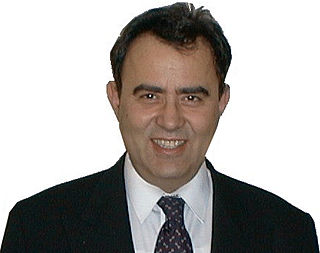Related Research Articles

In probability theory and related fields, a stochastic or random process is a mathematical object usually defined as a family of random variables. Stochastic processes are widely used as mathematical models of systems and phenomena that appear to vary in a random manner. Examples include the growth of a bacterial population, an electrical current fluctuating due to thermal noise, or the movement of a gas molecule. Stochastic processes have applications in many disciplines such as biology, chemistry, ecology, neuroscience, physics, image processing, signal processing, control theory, information theory, computer science, cryptography and telecommunications. Furthermore, seemingly random changes in financial markets have motivated the extensive use of stochastic processes in finance.

A Markov chain or Markov process is a stochastic model describing a sequence of possible events in which the probability of each event depends only on the state attained in the previous event. A countably infinite sequence, in which the chain moves state at discrete time steps, gives a discrete-time Markov chain (DTMC). A continuous-time process is called a continuous-time Markov chain (CTMC). It is named after the Russian mathematician Andrey Markov.
Applied probability is the application of probability theory to statistical problems and other scientific and engineering domains.
Athanassios Spyridon Fokas is a Greek mathematician, with degrees in Aeronautical Engineering and Medicine. Since 2002, he is Professor of Nonlinear Mathematical Science in the Department of Applied Mathematics and Theoretical Physics (DAMTP) at the University of Cambridge.
In queueing theory, a discipline within the mathematical theory of probability, the Pollaczek–Khinchine formula states a relationship between the queue length and service time distribution Laplace transforms for an M/G/1 queue. The term is also used to refer to the relationships between the mean queue length and mean waiting/service time in such a model.

In queueing theory, a discipline within the mathematical theory of probability, an M/M/1 queue represents the queue length in a system having a single server, where arrivals are determined by a Poisson process and job service times have an exponential distribution. The model name is written in Kendall's notation. The model is the most elementary of queueing models and an attractive object of study as closed-form expressions can be obtained for many metrics of interest in this model. An extension of this model with more than one server is the M/M/c queue.
Lajos Takács was a Hungarian mathematician, known for his contributions to probability theory and in particular, queueing theory. He wrote over two hundred scientific papers and six books.
In probability theory, a product-form solution is a particularly efficient form of solution for determining some metric of a system with distinct sub-components, where the metric for the collection of components can be written as a product of the metric across the different components. Using capital Pi notation a product-form solution has algebraic form
In queueing theory, a discipline within the mathematical theory of probability, quasireversibility is a property of some queues. The concept was first identified by Richard R. Muntz and further developed by Frank Kelly. Quasireversibility differs from reversibility in that a stronger condition is imposed on arrival rates and a weaker condition is applied on probability fluxes. For example, an M/M/1 queue with state-dependent arrival rates and state-dependent service times is reversible, but not quasireversible.

In applied probability, a regenerative process is a class of stochastic process with the property that certain portions of the process can be treated as being statistically independent of each other. This property can be used in the derivation of theoretical properties of such processes.
In queueing theory, a discipline within the mathematical theory of probability, an M/G/1 queue is a queue model where arrivals are Markovian, service times have a General distribution and there is a single server. The model name is written in Kendall's notation, and is an extension of the M/M/1 queue, where service times must be exponentially distributed. The classic application of the M/G/1 queue is to model performance of a fixed head hard disk.
Mathematical finance, also known as quantitative finance and financial mathematics, is a field of applied mathematics, concerned with mathematical modeling of financial markets. See Quantitative analyst.
In queueing theory, a discipline within the mathematical theory of probability, a fluid queue is a mathematical model used to describe the fluid level in a reservoir subject to randomly determined periods of filling and emptying. The term dam theory was used in earlier literature for these models. The model has been used to approximate discrete models, model the spread of wildfires, in ruin theory and to model high speed data networks. The model applies the leaky bucket algorithm to a stochastic source.

Michael N. Katehakis is a Professor of Management Science at Rutgers University. He is noted for his work in Markov decision process, Gittins index, the multi-armed bandit, Markov chains and other related fields.

Cyrus Derman was an American mathematician and amateur musician who did research in Markov decision process, stochastic processes, operations research, statistics and a variety of other fields.
In queueing theory, a discipline within the mathematical theory of probability, Ross's conjecture gives a lower bound for the average waiting-time experienced by a customer when arrivals to the queue do not follow the simplest model for random arrivals. It was proposed by Sheldon M. Ross in 1978 and proved in 1981 by Tomasz Rolski. Equality can be obtained in the bound; and the bound does not hold for finite buffer queues.
In probability and mathematical statistics, Ignatov's theorem is a basic result on the distribution of record values of a stochastic process.

In probability, statistics and related fields, a Poisson point process is a type of random mathematical object that consists of points randomly located on a mathematical space. The Poisson point process is often called simply the Poisson process, but it is also called a Poisson random measure, Poisson random point field or Poisson point field. This point process has convenient mathematical properties, which has led to it being frequently defined in Euclidean space and used as a mathematical model for seemingly random processes in numerous disciplines such as astronomy, biology, ecology, geology, seismology, physics, economics, image processing, and telecommunications.
François Baccelli is the Simons Chair in Mathematics and Electrical and Computer Engineering at the University of Texas at Austin, and head of the Simons Center on Communication, Information and Network Mathematics.

Asaf Hajiyev is the Secretary-General of the Parliamentary Assembly of the Black Sea Economic Cooperation, Former Member of National Assembly of the Republic of Azerbaijan, Doctor of Physical and Mathematical Sciences, Professor, Academician, Chair of Probability Theory and Mathematical Statistics in BSU.
References
- ↑ INFORMS. "Ross, Sheldon M." INFORMS. Retrieved 2021-04-12.
- ↑ Ross, Sheldon M. (September 1978). "Average delay in queues with non-stationary Poisson arrivals". Journal of Applied Probability. 15 (3): 602–609. doi:10.2307/3213122. ISSN 0021-9002.
- ↑ Rolski, Tomasz (September 1981). "Queues with non-stationary input stream: Ross's conjecture". Advances in Applied Probability. 13 (3): 603–618. doi:10.2307/1426787. ISSN 0001-8678.